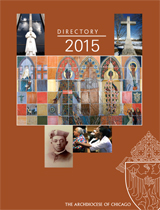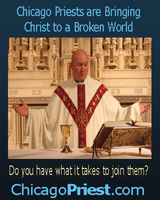December 7, 2008
Renovated Quigley dedicated
Using holy water gathered from the Marian shrine of Lourdes, France, during the archdiocesan pilgrimage earlier this year, Cardinal George blessed the offices of the Archbishop Quigley Center on Rush and Pearson streets at a prayer service and dedication on Nov. 19.
The Archbishop Quigley Center served most recently as Archbishop Quigley Preparatory Seminary until the high school seminary closed in June 2007. It will be the site of Cardinal George’s office and the workplace of about 250 staff members. Staff — including the offices of stewardship and development, legal services, communications and personnel services — was slated to move into the space Dec. 5. Other archdiocesan staff will move into the new Archbishop Meyer Center at 35th and Lake Streets. (See story in next issue about this site.)
Since renovation designs incorporated the French Gothic architecture of the building, which is a historic landmark, into the office space, staff who work at Quigley Center will be reminded day in and day out of the spiritual nature of the work that they do there.
The building’s chapel has also been renovated and will be used for Mass for staff during the weekdays and for other archdiocesan events.
Funds to renovate both Quigley and Meyer centers came from the leasing of the former pastoral center at 155 E. Superior St. and the sale of other archdiocesan properties, said Chancellor Jimmy Lago. It was the archdiocese’s goal to gather all of its administrative staff in one building but an adequate site with parking couldn’t be found so the twobuilding idea took shape, Lago said. Six archdiocesan sites will come together in both buildings.
Both Quigley and Meyer are on historic registries so care had to be taken in renovating the buildings to keep their original look.
Quigley Center is named after the second archbishop of Chicago, James Edward Quigley, who served from 1903 to 1915. During his tenure he started the minor seminary of the archdiocese, then called the Cathedral College of the Sacred Heart, and expanded the parochial school system.
 Catholic
New World - Newspaper for the Archdiocese of Chicago
Catholic
New World - Newspaper for the Archdiocese of Chicago Archdiocese of Chicago Directory
Archdiocese of Chicago Directory Oficjalne wydawnictwo Archidiecezji Chicago w języku polskim
Oficjalne wydawnictwo Archidiecezji Chicago w języku polskim